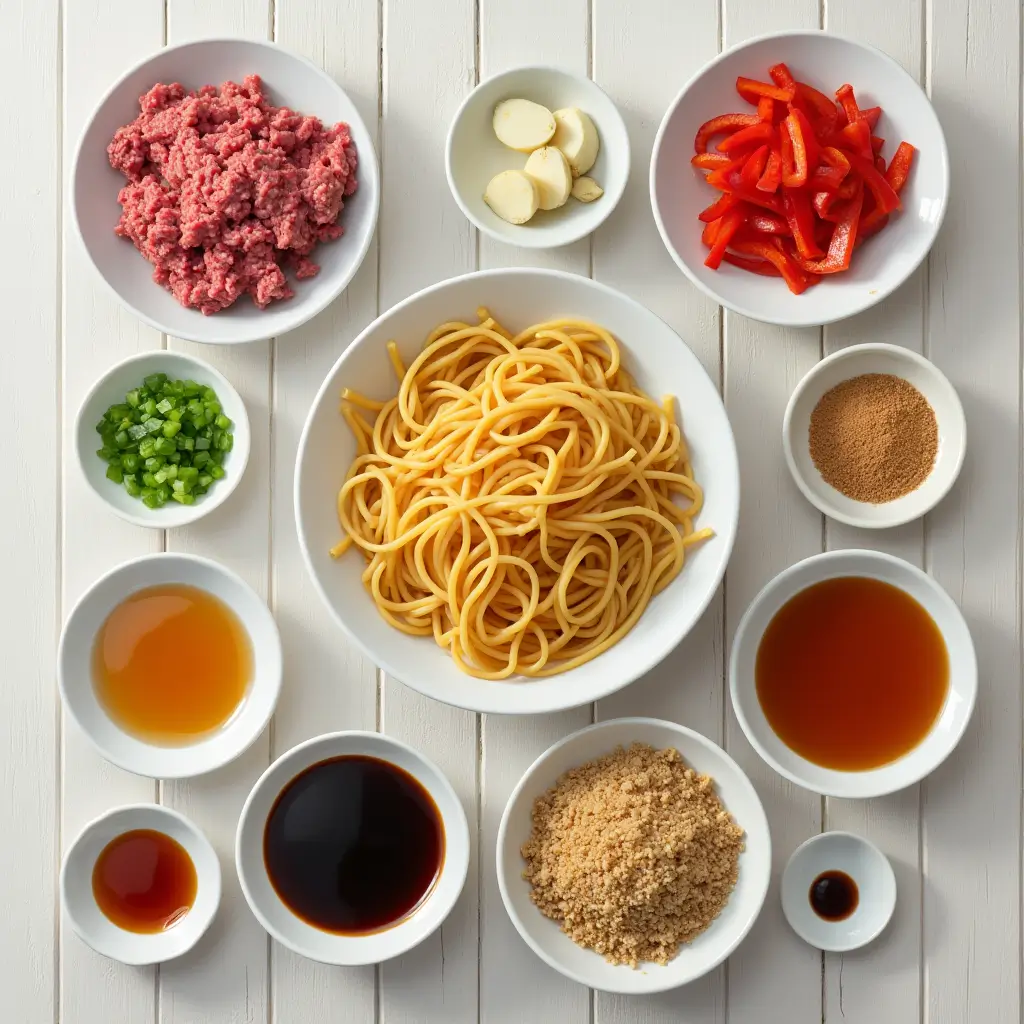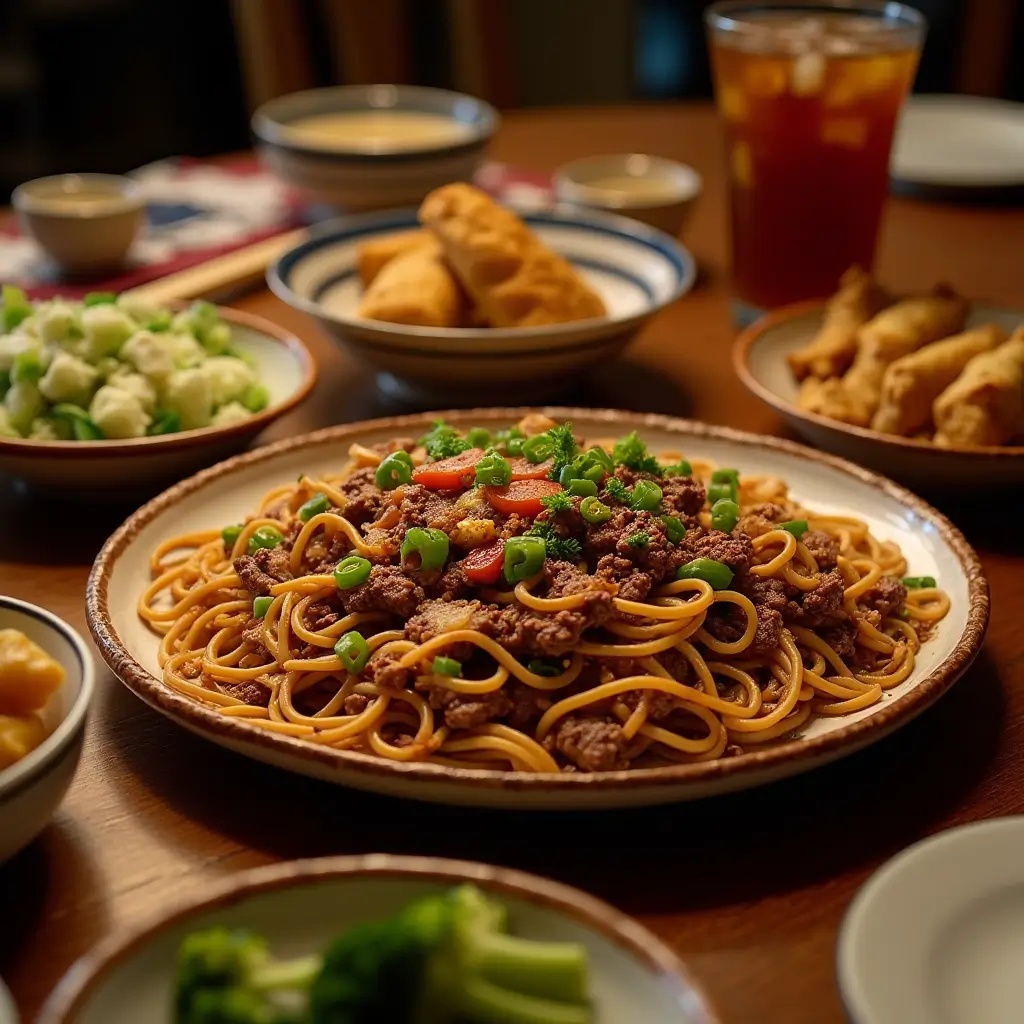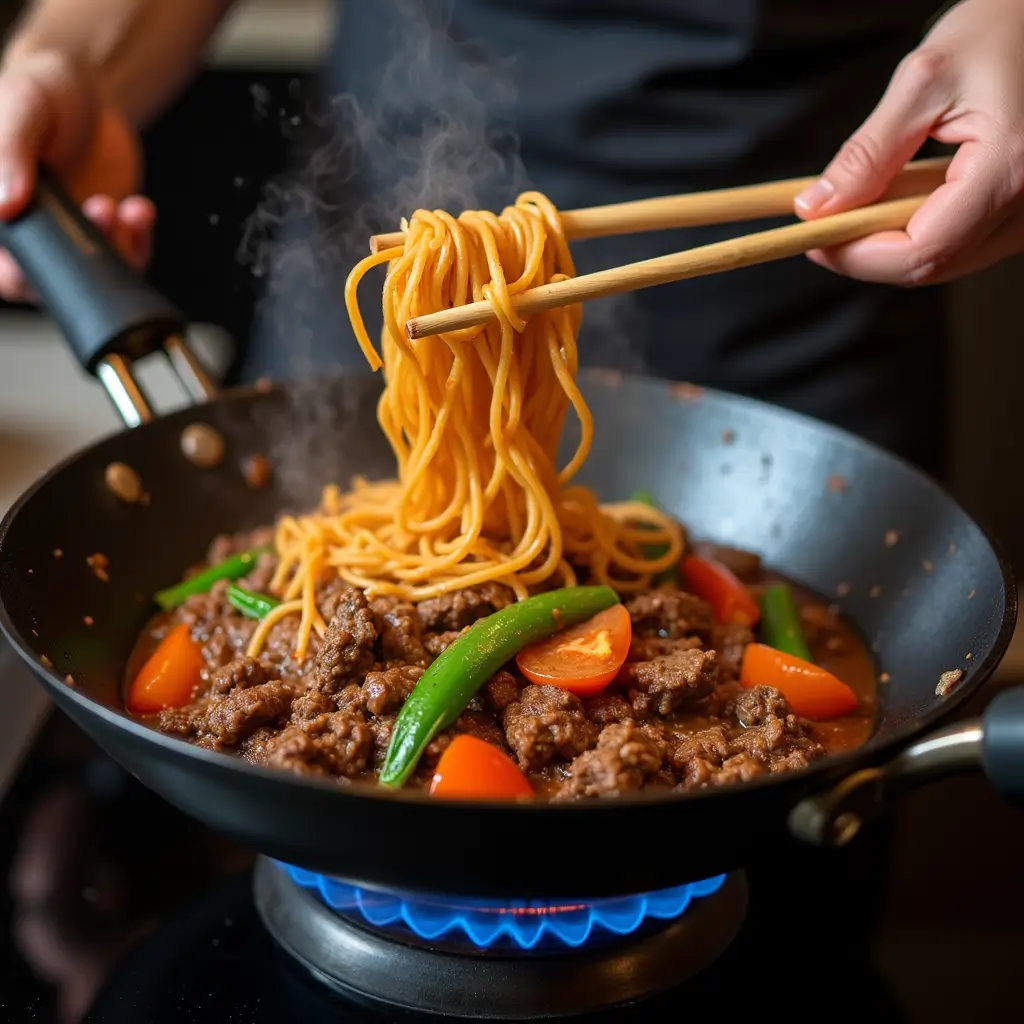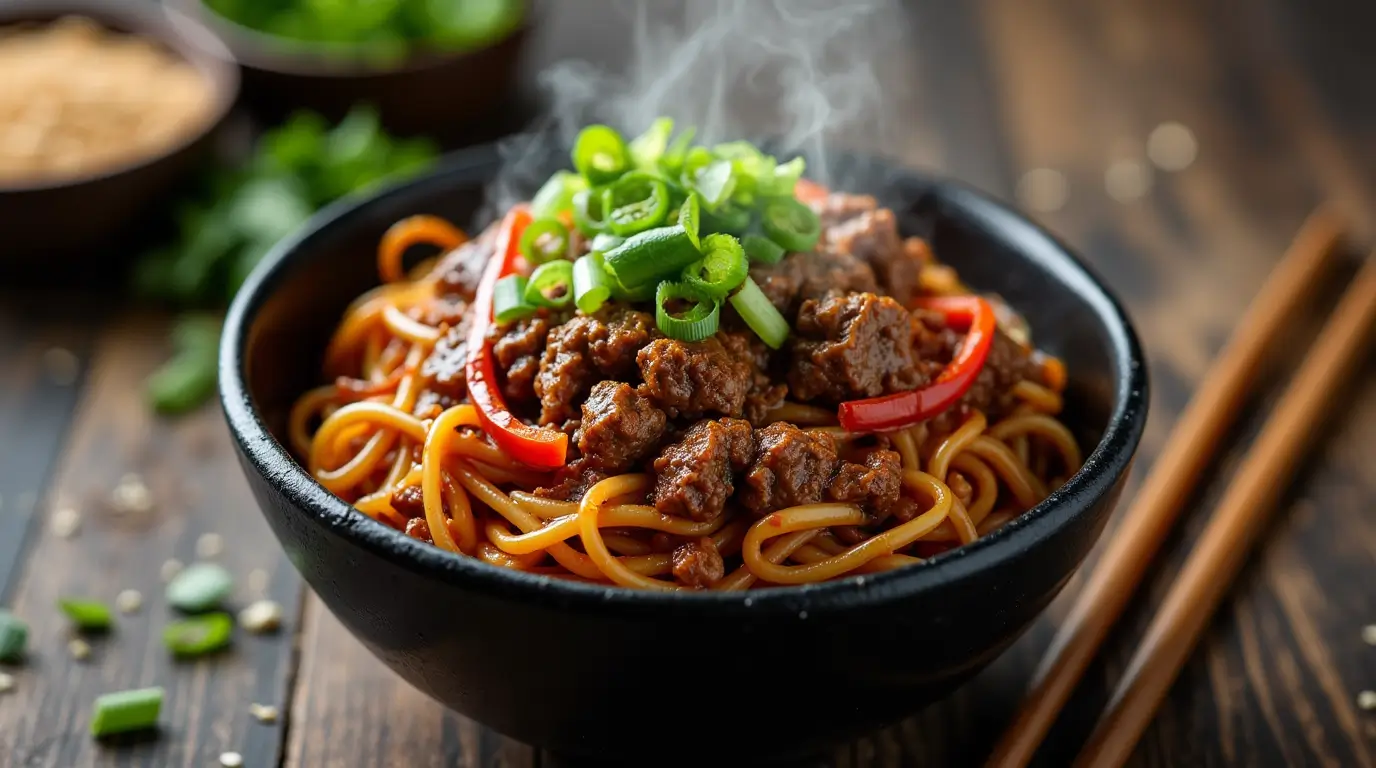Table of Contents
Introduction
The sizzle of beef hitting a hot wok takes me back to my first taste of Mongolian beef in a tiny family owned restaurant tucked away in San Francisco’s Chinatown. That perfect balance of sweet and savory, with tender strips of beef and springy noodles, became an instant obsession. But who has time to trek across town for takeout on busy weeknights? That’s why I developed this Mongolian Ground Beef Noodles recipan accessible, affordable twist on the classic that doesn’t sacrifice an ounce of flavor.
Unlike traditional Mongolian beef that uses thinly sliced flank steak, this version cleverly substitutes ground beef, making it budget friendly and significantly quicker to prepare. The beauty of these Mongolian Ground Beef Noodles lies in their simplicity you likely have most ingredients already sitting in your pantry, yet the flavor profile tastes like it required hours of preparation. Whether you’re feeding hungry kids after soccer practice or impressing dinner guests with your Asian cooking skills, this dish delivers restaurant quality taste with home kitchen simplicity.
Ingredients Breakdown & Substitutions
For the Mongolian Sauce:
- 1/2 cup low sodium soy sauce The foundation of our umami flavor; substitute coconut aminos for a gluten free, lower sodium alternative
- 1/3 cup brown sugar Creates that signature sweet savory balance; coconut sugar works well for a less refined option
- 1/4 cup water Thins the sauce to perfect consistency
- 2 tablespoons hoisin sauce Adds depth and complexity; use plum sauce as a substitute
- 1 tablespoon rice vinegar Provides acidity and brightness; apple cider vinegar can work in a pinch
- 2 teaspoons sesame oil Imparts that authentic Asian aroma; no great substitute, but a little olive oil with toasted sesame seeds can approximate the flavor
- 1 tablespoon cornstarch Thickens the sauce to coat the noodles beautifully; arrowroot powder is a good alternative
For the Beef and Noodles:
- 1 pound lean ground beef The star protein; ground turkey or plant based alternatives work for different dietary needs
- 8 oz lo mein or udon noodles Traditional choices for chew and sauce cling ability; rice noodles make a great gluten free option
- 1 tablespoon vegetable oil For stir frying; any neutral cooking oil works
- 4 cloves garlic, minced Aromatic base; garlic powder (1 tsp) can substitute if fresh is unavailable
- 2 tablespoons fresh ginger, grated Provides essential warmth and spice; ground ginger (1 tsp) works but lacks some brightness
- 3 green onions, sliced Both for cooking and garnish; chives can substitute
- 1 small red bell pepper, julienned Adds color and nutrition; any bell pepper color works well
- Optional: 2-3 dried red chilis For heat lovers; red pepper flakes can substitute
Don’t worry if you’re missing an ingredient or two this Mongolian Ground Beef Noodles recipe is incredibly forgiving and adaptable to what you have on hand!

Step by Step Instructions with Expert Tips
Prepare the noodles. Cook according to package directions until just al dente. Don’t overcook! They’ll continue cooking slightly when added to the beef. Rinse under cold water to stop cooking and prevent sticking. Pro tip: Toss with a tiny bit of sesame oil to keep noodles separated while you prepare the rest of the dish.
Mix the Mongolian sauce. In a bowl, whisk together soy sauce, brown sugar, water, hoisin sauce, rice vinegar, and sesame oil until sugar dissolves. In a separate small bowl, mix cornstarch with 1 tablespoon cold water to create a slurry, then whisk into sauce mixture. Pro tip: Taste the sauce before adding to the dish this is your opportunity to adjust sweetness, saltiness, or acidity to your preference.
Brown the ground beef. Heat vegetable oil in a large wok or skillet over medium high heat. Add ground beef, breaking it up with a wooden spoon. Cook until no pink remains, about 5-7 minutes. Drain excess fat if necessary. Pro tip: Don’t stir constantly let the meat develop some brown, crispy edges for enhanced flavor.
Add aromatics. Push beef to one side of the pan and add garlic and ginger to the empty space. Cook for 30 seconds until fragrant, being careful not to burn the garlic. Pro tip: If your stovetop runs hot, lower heat slightly for this step.
Incorporate vegetables. Add white parts of green onions and bell pepper strips. Stir fry for 2 minutes until vegetables begin to soften but still maintain some crispness. Pro tip: Adding a tablespoon of water and covering for 30 seconds creates steam to help vegetables cook evenly.
Combine with sauce. Pour the Mongolian sauce over the beef mixture and stir to combine. Bring to a simmer and let cook for 2-3 minutes until sauce thickens and becomes glossy. You want it thick enough to coat a spoon. If sauce becomes too thick, add water 1 tablespoon at a time.
Toss with noodles. Add cooked noodles to the wok and gently toss until everything is well coated with sauce and heated through. Garnish with remaining green onion tops and serve immediately. Pro tip: Reserve a few tablespoons of sauce to drizzle over individual servings for extra flavor impact.
Why This Recipe Is a Must Try
• Ready in 30 minutes perfect for busy weeknights when you crave takeout but need something quicker
• Budget friendly uses ground beef instead of expensive cuts like flank steak
• One pan wonder minimal cleanup makes this ideal for weeknight cooking
• Customizable heat level easily adjusted from kid friendly mild to spice lover hot
• Balanced flavor profile hits all notes: sweet, savory, umami, with a hint of acidity
• Versatile base recipe can be modified based on what vegetables you have on hand
• Crowd pleaser familiar enough for picky eaters but flavorful enough for adventurous palates
• Better than takeout control ingredients, sodium, and oil for a healthier version of your favorite
• Impressive presentation looks restaurant worthy with minimal effort
Storage, Make Ahead & Freezing Tips
These Mongolian Ground Beef Noodles actually improve with time as the flavors meld, making them perfect for meal prep and leftovers. Here’s how to handle them:
Refrigerator Storage:
Store cooled leftovers in an airtight container in the refrigerator for up to 3 days. The noodles will absorb more sauce as they sit, intensifying the flavors.
Freezing Instructions:
While you can freeze this dish, I’ve found the noodles can become slightly mushy upon thawing. For best results, if planning to freeze, slightly undercook the noodles and freeze the beef mixture separately. Store in freezer safe containers for up to 2 months.
Reheating Methods:
For the best texture, reheat stovetop in a skillet with a splash of water or beef broth to loosen the sauce. Microwave works in a pinch cover with a damp paper towel and heat in 30-second intervals, stirring between each.
Make Ahead Tips:
Prepare the sauce up to 3 days ahead and store refrigerated. You can also brown the beef with aromatics and refrigerate up to 24 hours before finishing the dish.
I once prepped this entire meal during my Sunday meal prep and turned it into three different dinners throughout the week: classic Mongolian beef noodles the first night, then used leftovers in lettuce wraps, and finally transformed the last portion into fried rice by chopping everything smaller and adding an egg. Talk about versatile!
Creative Variations & Serving Ideas
Spicy Szechuan Style:
Add 1-2 tablespoons of chili oil and 1 teaspoon of Szechuan peppercorns for a numbing, spicy kick that transforms the dish.
Vegetable Boost:
Turn this into a complete one pot meal by adding broccoli florets, snow peas, or mushrooms during cooking.
Crispy Noodle Version:
Instead of soft noodles, serve the beef mixture over fried chow mein noodles for a delightful textural contrast.
Lettuce Wrap Conversion:
Skip the noodles entirely and serve the savory beef mixture in butter lettuce cups for a lower carb option.
Morning Glory:
Transform leftovers into an incredible Asian inspired breakfast by topping the reheated beef noodles with a fried egg.
Perfect Pairings
These Mongolian Ground Beef Noodles pair beautifully with:
- Steamed or roasted broccoli
- Asian cucumber salad
- Egg rolls or dumplings
- Hot and sour soup as a starter
- Jasmine or coconut rice (for extra carb lovers!)
- Cold Tsingtao beer or a slightly sweet Riesling
- Bubble tea for a fun, authentic drink pairing
For an impressive dinner party, I like to serve this family style in the center of the table alongside smaller dishes of pickled vegetables, steamed buns, and a variety of Asian condiments like chili crisp, extra hoisin, and soy sauce.

Nutrition Value
| Nutrient | Amount per Serving |
|---|---|
| Calories | 425 |
| Protein | 28g |
| Carbohydrates | 46g |
| Fat | 14g (4g saturated) |
| Fiber | 3g |
| Sugar | 12g |
| Sodium | 720mg |
| Iron | 20% DV |
| Vitamin C | 35% DV |
Serving size: 1/4 of recipe (approximately 1.5 cups)
This Mongolian Ground Beef Noodles recipe is naturally dairy free and can be made gluten free by substituting tamari for soy sauce and using rice noodles instead of wheat based options. It’s higher in protein than many takeout versions, with the bonus of being lower in oil and sodium. Values calculated using the USDA Food Database and are approximate based on specific ingredients used.
If you enjoyed this recipe, you might also like :
- Easter Appetizer Recipes
- Easter Dessert Recipes
- Cottage Cheese Banana Bread
- 4 Reasons You’ll Love Making Gluten Free Dumplings
- Mezcal Negroni Recipe
Expert Tips
After making this Mongolian Ground Beef Noodles recipe dozens of times (both at home and in cooking classes I’ve taught), I’ve gathered some game changing insights:
Brown beef properly: Don’t crowd the pan and allow some caramelization to develop. These browned bits are flavor gold mines.
Noodle timing matters: Slightly undercook your noodles as they’ll continue to absorb sauce in the wok. No one wants mushy noodles!
Balance is key: The perfect Mongolian sauce walks the tightrope between sweet and savory. Start with less sugar and add more to taste you can’t take it out once it’s in.
Layer your aromatics: Add garlic and ginger at different times to prevent burning and maximize flavor development.
Sauce consistency trick: The sauce should coat the back of a spoon but still flow. If too thin, mix another teaspoon of cornstarch with cold water and add gradually.
Prep everything first: This stir fry moves quickly once you start cooking. Having everything chopped, mixed, and ready (mise en place) prevents burning or overcooking.
Heat management: A properly hot wok or pan creates that restaurant-quality sear without steaming the ingredients. If you hear sizzling, you’re doing it right!

FAQs
What is Mongolian beef sauce made of?
Mongolian beef sauce combines soy sauce, brown sugar, and water as its base, enhanced with aromatics like garlic and ginger. Unlike other Asian sauces, it doesn’t contain oyster sauce but gets its distinctive flavor from the balance of sweet and savory elements. In our Mongolian Ground Beef Noodles recipe, we add hoisin sauce and rice vinegar to create greater depth and brightness.
How would you describe Mongolian beef?
Mongolian beef is a Chinese American creation (not actually Mongolian!) characterized by its sweet savory balance with slight caramelization on the beef. The dish typically has a glossy sauce that’s rich but not overly heavy. Our ground beef version maintains all these signature flavors but in a more accessible format that cooks more quickly and evenly than traditional sliced beef.
What are the crispy noodles in Mongolian beef?
Traditional Mongolian beef is sometimes served over crispy cellophane noodles (made from mung bean starch). For a similar effect in our Mongolian Ground Beef Noodles recipe, you can substitute the soft lo mein noodles with crispy chow mein noodles or even fry your own noodles by briefly deep frying cooked lo mein in hot oil until crispy.
How to make Mongolian sauce?
To make authentic Mongolian sauce, whisk together 1/2 cup low sodium soy sauce, 1/3, cup brown sugar, 2 tablespoons hoisin sauce, 1/4 cup water, 1 tablespoon rice vinegar, and 2 teaspoons sesame oil until well combined. Then create a slurry with 1 tablespoon cornstarch and 1 tablespoon cold water, and mix it into the sauce. This sauce is versatile enough to use with beef, chicken, or even tofu.
What is the seasoning in Mongolian ground beef?
The signature seasoning in Mongolian ground beef comes primarily from the sauce rather than dry spices. The key flavor components include soy sauce, brown sugar, hoisin sauce, and fresh aromatics like garlic and ginger. Unlike other Asian dishes, Mongolian beef doesn’t typically use five spice powder or chili paste in its base recipe, though these can be delicious additions for variation.
Conclusion
From my kitchen to yours, these Mongolian Ground Beef Noodles represent everything I love about home cooking taking inspiration from restaurant favorites and transforming them into something more accessible, adaptable, and often even more delicious than the original. The beauty of this dish lies not just in its incredible flavor balance but in how easily it fits into real life.
I’d love to know how this recipe works in your kitchen! Did you stick to the traditional ingredients or make substitutions based on what you had available? Did your family request it be added to the regular rotation? The beauty of cooking is how we each bring our own touch to recipes, making them uniquely ours.
If you enjoyed these Mongolian Ground Beef Noodles, you might also love my Quick Beef and Broccoli Stir Fry, 20-Minute Pad Thai, or Homemade Teriyaki Chicken Bowls all designed with the same philosophy of bringing authentic Asian flavors to your everyday cooking with minimal fuss.
Don’t forget to save this recipe, share it with friends who are looking for quick dinner solutions, and follow along for more weeknight dinner rescues that never sacrifice flavor for convenience. Happy cooking!
Don’t forget to subscribe to my newsletter for more globally inspired seafood recipes delivered straight to your inbox, and follow me on PINTEREST TidbitRecipe where I share behind the scenes cooking tips and kitchen experiments!


2 thoughts on “Mongolian Ground Beef Noodles: 7 Steps to Authentic Asian Flavor”
Comments are closed.